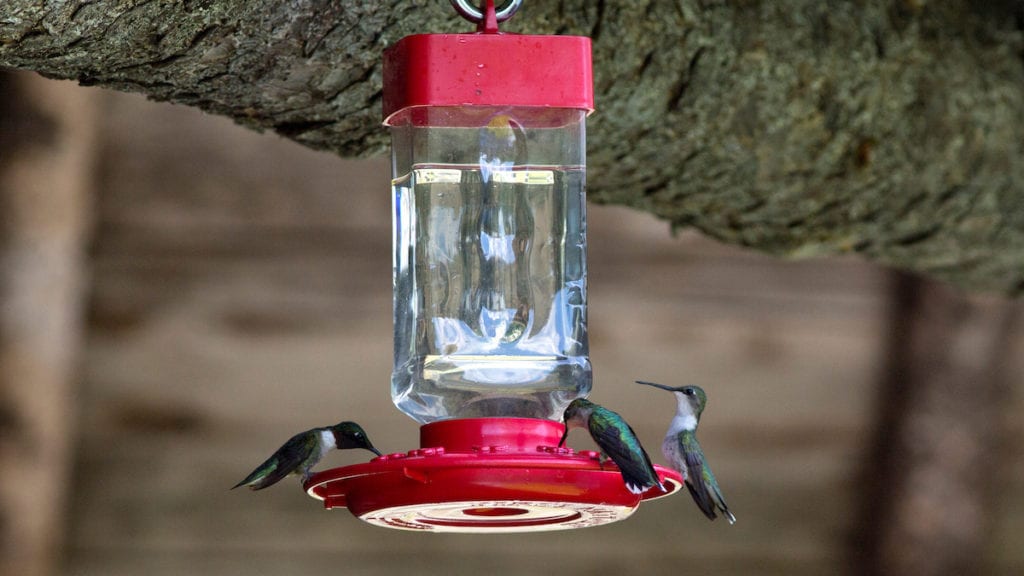
You can tell it is October when we start using words like Selasphorus or Archilochus – these two mouthfuls are the genera of some of the hummingbirds that occur in North America, which could be in your yard right now. Even though mostly all of our Ruby-throated Hummingbirds have left Maine by the first week of October, you should still keep your hummingbird feeders up! We beat this drum each fall and — given the successes of last year — we are beating it again (and hopefully even louder).
This worked last year! You can read the whole story here. But the summary is: We got a call about a late hummingbird in Cape Elizabeth, which turned out to be a Ruby-throated Hummingbird (still a great record!). We shared that report and encouraged other to put their feeders up on October 16th. One member, Carole G. Jean, read that post and put her feeder back up on the 19th. On the 20th, she had a Selasphorus hummingbird visiting!
To make another long story short, we are still working out the ID of this bird. Selsaphorus hummingbirds can be very difficult to identify to species and often require a licensed bander to come catch the bird and take precise measurements. Some birds can be identified using a photograph of the spread tail feathers but only a couple blurry photos exist of this bird’s tail. The Maine Bird Records Committee is in their third and final round of voting/discussions about this bird…
Expanding our knowledge.
Along with the putative Rufous Hummingbird in Portland, there was also a Ruby-throated Hummingbird found in South Portland visiting blooming Pineapple Sage (Salvia elegans) and later supplemented with a feeder. Blowing past previously known late dates, this bird survived until December 15th, making it to ‘count week’ of the Greater Portland Christmas Bird Count (CBC) and representing the first hummingbird ever on a Maine CBC!
Let us know if you see any hummingbirds!
Shoot me an email at naturalist@maineaudubon.org if you see any hummingbirds still buzzing around. Even if it appears to be a Ruby-throated Hummingbird, it could actually be the western Black-chinned Hummingbird. Or perhaps it is time for another Calliope Hummingbird (the US’s smallest hummingbird) to return to Maine (there are two previous records, from Monhegan Island on 6 Oct 2005 and Blue Hill from 23 Oct – 1 Nov 2008).
And here are a few FAQs we receive about feeding hummingbirds:
Does this keep them from migrating?
No. If anything, it probably helps. More important than food in hummingbird migration timing is the change in photoperiod. As days get shorter, hummingbirds are ‘cued’ that it is time to migrate south. Food is too variable a migratory prompt for hummingbirds, but they need an abundance of it to bulk up before making their long journeys. By putting feeders up late in the fall, you could be giving these late or vagrant hummingbirds a boost of food that they need before they can make the next jump in their migration.
Can I use raw sugar or honey instead of white sugar?
No. Use a mixture of four parts water to one part plain white sugar. From this great Audubon article Turn Your Yard Into A Hummingbird Spectacular:
“…never use honey, which promotes dangerous fungal growth, molasses, or brown, raw, or organic sugar, which contain levels of iron that could be lethal. Plain white sugar perfectly mimics the chemical composition of natural nectar; don’t waste money on commercial mixes. It’s not necessary to boil the water, but keep any extra nectar refrigerated, and empty the feeder every few days, more often in hot weather. Never use red dye; nectar is naturally clear, and the coloring could be harmful.”
Give those feeders a good scrubbing, fill them up, hang them outside, and let us know if you see anything!
-Doug
